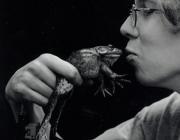Citation:
Abstract:
During mating, the female Carolina ground cricket (Eunemobius carolinus (Scudder, 1877)) chews specialized spurs on the male’s hind tibia for access to his hemolymph. One potential benefit to spur chewing includes nutritional acquisition from male hemolymph. A method for testing this hypothesis is to manipulate food quality or quantity, with the prediction that mating rate will increase as food quality or quantity decreases. We manipulated diet quality in adult females and provided them with four consecutive mating opportunities. We measured four aspects of mating behaviour (mating rate, latency to copulate, copulation duration, and spur chewing duration) and three of female fitness (egg number, egg-laying rate, and life span). Females of the two diet treatments did not differ significantly in any of the measured mating behaviours, although females fed a low-quality diet lived longer. Male life span did not correlate with any measured variable, although males that experienced more matings and longer total times of copulation and spur chewing lost more mass. These results suggest that spur chewing may be costly for males, although we detected no evidence that this behaviour was a benefit to the female or represented a form of male coercion.


